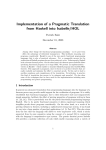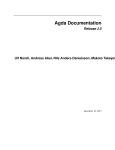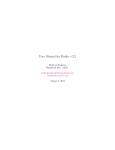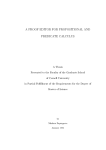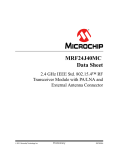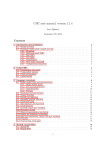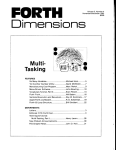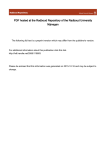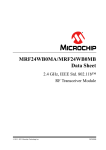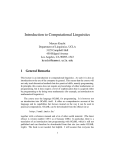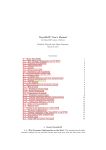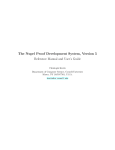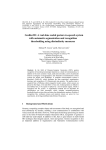Download Notes - Computer Science
Transcript
CS3110 Fall 2013 Lecture 2:
Evaluation of Expressions, Types,
Recursion (9/3)
Robert Constable
September 3, 2013
1
Lecture Plan and Overview
1. Lecture Plan and Overview
2. Review: syntax, evaluation
3. Evaluation by reduction rules, substitution model
4. OCaml types and type inference
5. Typing rules and type inference
6. Recursion and induction
7. Summary
The first topic of the lecture will be evaluation and the role of types in
OCaml evaluation. OCaml’s theory of computation requires a strong
understanding of types, so we mention briefly the wider mathematical
theory of types. We also look more closely at recursive functions as
preparation for Problem Set 1, and we discuss induction as well which is
part of the problem set. We start with a brief review of the technical
elements of Lecture 1 and mention good questions from students.
1
Suggested Reading: This lecture is closely related to Lecture 2 by
Professor Kozen in Spring 2011. Also, the textbook by Jason Hickey,
http://courses.cms.caltech.edu/cs134/cs134b/book.pdf. Chapter 2 has an
excellent account of types. You should glance at the OCaml Reference
Manual on types as well, http://caml.inria.fr/pub/docs/manual-ocaml/.
2
Review: syntax, evaluation
We have seen the elements of OCaml syntax and have started discussing
the evaluation rules in the form of reduction rules or rewrite rules. We
discussed the definition of canonical values in an evaluation system based
on reduction rules.
There was a good question after class about why f un x → x ∗ x is a
canonical value when inside the function body we have the multiplication
operator which we know is a non-canonical form, e.g. 3*3 reduces to 9. The
point is that there is no value for the multiplication operator to work on
until the function is applied, so the inside of the body can’t be reduced.
This is canonical in the same sense that the operator expression ? is
canonical, as is +.1
This leads to a more subtle example, what about the function
f un x → 3 ∗ 5
is this a canonical value?
The answer is yes and you can test it by writing the function in the OCaml
top loop. OCaml will respond with exactly this message.
− :0 a → int =< f un >.
The fact that this constant function is canonical is determined by looking
1
A person might also think that f un x → f un y → x ? y is just like the ? multiplication
operation. What do you think? Might ? be equal to f un p → let (x1 , x2 ) = p in x1 ∗ x2
or if we wrote let times = f un p → let (x1 , x2 ) = p in x1 ∗ x2 , then would times = ??
2
at the outer most constructor of the expression, the key word f un. This
operator name tells us that the expression is canonical without looking
inside at all.
2.1
historical aside: the lambda calculus, Lisp,
Classic ML, and abstract syntax
lambda notation In the language Classic ML, function values are
written as \x.body. This is the closest ascii representation of the function
notation in the lambda calculus [3] created by Alonzo Church.2 In the
lambda calculus this would be written λx.body and the identity function is
just λx.x a very compact notation. The outer operator is λ. From time to
time we’ll use the lambda notation in an informal way to remind you of the
connection. Mentioning the lambda calculus from time to time is an
historical and cultural side note for the lectures.
Church’s lambda calculus provided a way to write functions precisely
compared to the standard notation in mathematics. We still see that most
mathematics books would write a function like λx. x × x as y = x × x.
They would write the sine function as y = sine(x) and a general function f
as y = f (x). His colleagues in the mathematics department at Princeton
did not find Church’s function notation very appealing and did not use it.
Probably even 74 years later most of them still wonder what “all the fuss is
about.” You can see that in the Cornell Mathematics Department as well.
Mathematics books are divided about whether a function is a rule or a set
of ordered pairs. For this course, a function means a partial computable
function.
Lisp from the lambda calculus By 1962 Church’s lambda calculus
from 1940 inspired one of the most innovative and influential programming
languages, Lisp [7], still heavily used today. Lisp treated functions as first
class objects and introduced many other fundamental concepts in modern
2
American Standard Code for Information Interchange is abbreviated as ascii or ASCII.
In Lecture 1 we discussed briefly the ISO8859-1 character set, an ASCII extension.
3
computer science such as abstract syntax trees, garbage collection, reflection
of programs as data, formal rules of evaluation, rules for proving properties
of programs, and the idea of proof checking as well as other fundamental
notions. In one of the most influential foundational articles of the field, A
Basis for a Mathematical Theory of Computation [6] by John McCarthy
sketched a theory of computation on which the OCaml theory is based.3
McCarthy was a graduate student at Princeton where he learned about
Church’s lambda calculus. A key concept from Lisp’s abstract syntax is
helpful right at this point in thinking about OCaml.
The Lisp programming language is a signature accomplishment of the MIT
computer science department. A company was spun off from MIT that
made Lispmachines. In these machines even the operating system was
written in Lisp, it was “Lisp all the way down.” MIT also developed the
forerunner of programming courses such as CS3110, it was based on Lisp.
The textbook for the MIT course is still widely known and respected:
Structure and Interpretation of Computer Programs [1].
abstract syntax Note, for the pairing operator, as in (0, true) the syntax
does not reveal an outer operator as clearly and simply as it does for
functions where the outer operator is f un (or λ). Abstractly a pair has an
outer operator, and we can think of pairs as pair(0, true), also internally, in
the compiler, the outer operator of its abstract syntax tree is pair.
For conceptual clarity, we will “make up” outer operators from time to time
when they help clarify an OCaml concept, but they are not official OCaml
syntax. It is very convenient to have an outer operator when we discuss
canonical and non-canonical expressions. Indeed, this approach to syntax
3
One of the most inspiring paragraphs in any of the early papers on computer science
is this opening by McCarthy. “Computation is sure to become one of the most important
of the sciences. This is because it is the science of how machines can be made to carry
out intellectual processes. We know that any intellectual process that can be carried out
mechanically can be performed by a general purpose digital computer. Moreover, the
limitations on what we have been able to make computers do so far clearly come far more
from our weakness as programmers than from intrinsic limitations of machines. We hope
that these limitations can be greatly reduced by developing a mathematical science of
computation.”
4
from Lisp is called abstract syntax.
Notice that Alonzo Church of the Princeton mathematics department was
featured in our “short history” about the lambda calculus. He was one of
the first major American logicians, one of the first mathematicians to
discover a provably unsolvable problem in mathematics. He was also the
host for Alan Turing’s visit to America based on the fact that Turing had
independently discovered unsolvability at about the same time. One could
say that “Church brought computer science to America” in the person of
Alan Turing in 1937 and though his influence on McCarthy and other
pioneering computer scientists whom we will mention later. I don’t think
anyone realized at the time how important these influences were. We
already mentioned Church’s connection to Lisp.
Church’s Simple Type Theory Church was also one of the founders of
modern type theory [2] which is key to OCaml. For some reason McCarthy
did not think of adopting Church’s type theory to Lisp. It would be very
interesting to understand why that happened – can we say that a class of
non-events happened? I think one reason is that McCarthy believed that
the computation system should come first, and that it was fundamentally
untyped. There is a great deal of merit in thinking that computation comes
before types, but also a great deal of merit in realizing that types are
conceptually essential to reasoning – something Aristotle understood; he
called them categories.
Church’s type theory is implemented in the family of proof assistants based
on Higher Order Logic, these are called HOL provers. HOL-light is used by
Intel to verify floating point operations on its chips. HOL is widely used in
Europe and it has a feature to produce its proofs in a natural language
format.
5
3
Evaluation by Reduction Rules
We refer back to the last section of the written Lecture 1 notes; there
reduction rules are discussed briefly and some examples are given. Here we
repeat the rule for evaluating function application.
Function Application Rule
exp2 ↓ v2 , exp1 ↓ f un x − > body(x), body(v2 /x) ↓ v3 ` (exp1 exp2 ) ↓ v3 .
Notice the order of evaluation, we evaluate the argument, exp2 first. If that
expression has a value, then we evaluate exp1 and if that evaluates to a
function f un x − > body(x), then we substitute the value v2 for the
variable x in body and evaluate that expression. This is called eager
evaluation or call by value reduction because we eagerly look for the input
to the function, even before we really know that exp1 evaluates to a
function.
There is another order of function evaluation in programming languages
called lazy evaluation. To evaluate exp1 exp2 lazily, first evaluate exp1 to
make sure it is a function, then substitute exp2 for the variable in the body.
Whether exp2 is evaluated depends on the evaluation of the body. For
example, a constant function such as f un x − > 0 does not use the value
of the input to construct its result. Likewise the identity function,
f un x − > x can produce output without evaluating the input first –
nevertheless, OCaml will evaluate it. OCaml supports lazy evaluation as
well, and we will discuss that topic later.
These simple rules might seem tedious, but they are the basis for a precise
semantics of the language that both people and machines can use to
understand programs. By writing down all these rules formally, we create a
shared knowledge base with proof assistants that can help us reason about
evaluation.
divergence In all of the evaluation rules for OCaml it is possible that the
expression we try to evaluate will diverge, meaning “fail to terminate”.
6
That is, the evaluation process runs on indefinitely until memory is
exhausted or until you get tired of waiting and intervene to stop the
evaluation process which is diverging. We can write very simple programs
that will loop forever without using up memory (and thus is not caught by
the OCaml stack overflow detector).
Question: Could OCaml support a compiler feature that detected whether
evaluation of any given expression exp would diverge?
exceptions Evaluation might also just “get stuck” as when we try to
apply a number to another number, as in 5 7 or take the first element of a
function value, e.g. f st f un x − > (x, x) or divide by 0. Such attempts to
evaluate an expression do not make sense and would get stuck if we tried to
evaluate them. The run time system can detect these bad states of the
evaluation process. When this happens OCaml can report an error called
an exception. We discuss exceptions later.
We will see that the type system helps us avoid expressions whose
attempted evaluation would “get stuck”, but we cannot avoid all such
situations by type checking. Later we will discuss computations that cause
exceptions, which is a response to evaluations that become stuck even
though they are well formed (pass the type checker).
As written in Lecture 1, reduction rules can be presented in several styles.
We are using a style that is easy to write down in a single linear expression
called a sequent.
Sequents have the form
hyp1 , ..., hypn ` concl.
Recall the following rule from Lecture 1.
Rule Boolean-or
exp1 ↓ true ` (exp1 || exp2 ) ↓ true
The symbol ` is called a turnstile because it resembles a very simple
turnstile device that might be used to count people entering a store. Note
7
that the parentheses around exp1 || exp2 are to make the scope of the
reduction operation ↓ clear, the OCaml expression might not have these out
parentheses.
This method is called structured operational semantics or small step
semantics and was developed by Gordon Plotkin at Edinburgh University.
Gordon has made numerous important contributions to theoretical
computer science from his base in Scotland. His idea for semantics is now
used in logic and type theory as well. A similar method was developed by
Gilles Kahn, a French computer scientist at INRIA (Institut National de
Recherche en Informatique et en Automatique). Kahn’s method is called
big step semantics or natural semantics [5, 4].
This semantic method is designed to present semantics in a style that is
easy for people to understand and reason about. It does not mimic what
the computer actually does step by step, but it is faithful to the computer’s
operation. We say that the computer’s operations are a refinement of this
reduction rule semantics. Using this formal semantic model, we can easily
prove properties of OCaml’s computation system. For example, we can
easily see that if an expression involving boolean or, bexp1 || bexp2 , has the
property that bexp1 reduces to the value true, then it will do so even if
bexp2 fails to terminate. On the other hand, if bexp1 fails to terminate,
then even if bexp2 terminates with value true, the disjunction fails to
produce a value. We will see that this failure to terminate is a possibility
for Boolean expressions defined by recursive procedures and by loops.
There are too many rules for OCaml evaluation to include them all in these
notes or even in the OCaml User’s Manual. On the other hand, the class
could easily assemble a complete set of rules as a crowdsourcing project. In
this lecture we examine more rules and sketch some properties of the
OCaml evaluation system. Then we reflect on the method as applied to
function evaluation and talk about the scope of the declaration of the
function’s inputs and about how reduction is done by substitution of values
for arguments in the function body. This leads us to examine types,
especially the types of functions.
8
4
OCaml types and type inference
In order to define OCaml evaluation of expressions, we first need to
understand elements of the OCaml type system. This is because before
OCaml evaluates an expression exp, it first checks to see if it has a type.
Expressions that have a type make sense at some level as either programs
or data. OCaml tries to infer a type for exp. If it succeeds, then the term is
evaluated. Moreover, the evaluator can take advantage of the information
gathered by type inference. If OCaml cannot infer a type, then it will not
attempt to evaluate the expression because the result won’t make sense or
the computation process might get stuck or might go on forever.
Definition: To define a computational type T we provide a canonical name
for it, and we say how to form expressions that are canonical values of that
type. Each OCaml type is the partial type of an underlying computational
type in mathematics. The partial type includes all expressions that are in
the “mathematical type” if they converge.
Design Invariant: OCaml is designed to have the property that if an
expression exp is assigned the type t by the typing rules or the type
inference algorithm, then if the expression exp converges to a value, it will
be a canonical value of the underlying mathematical type of t.
I do not know of a proof that OCaml satisfies this design invariant.
The type inference algorithm will catch some but not all instances of
expressions that will not evaluate properly because they do not make sense,
e.g. attempting to add an integer to a Boolean or multiplying a function by
a character string. In these cases the operation is not defined, and in some
cases we can’t even imagine what kind of value might result if any.
undefined operations The type checker/inferencer cannot check against
all the reasons that computation does not make sense. For example, OCaml
does not allow division by 0, so 17 divided by 0, 17/0, does not make sense.
But the type checker will not be able to determine whether a divisor, say d
in the expression n/d, is 0 or not. Likewise, when we are defining the
9
rational numbers, such as 1/2, we use ordered pairs (1, 2) and we will not
be able to rule out (1, 0) as a rational number using only the typing rules.
diverging computations No type checker for OCaml can decide in
advance whether the evaluation of an expression halts. This is called the
halting problem, and it is a fundamental result of computing theory that for
any universal programming language, i.e. one that is capable of defining all
partial computable functions, it is not possible to recognize by an algorithm
all cases where the algorithm will fail to halt. OCaml is a universal
language in this sense.4
advantages of type checking We do not see the advantages of type
information at the granularity of reduction rules, but the OCaml compiler
can use type information to improve the way modern computer hardware
implements evaluation. For instance, the type checker can provide
information that lays out expressions efficiently in memory, e.g. we know
that we need only one bit of information to store a Boolean value.
The collection of all OCaml types is defined inductively, that is, we start
with the atomic types and define how to build new types using operators
called type constructors. OCaml does not have a type that includes types as
values. There are programming languages that do, the Agda, Coq, and
Nuprl languages all treat types as values, e.g. they can say int ² T ypei .
4.1
atomic types
Please read Kozen’s Lecture 2 in 2009 and his Lecture 3, pages 1 and 2.
Also see Recitation 1 from 2009. You will also find Hickey’s chapter on
types very clear. Here are some of the OCaml atomic type expressions.
4
Universal programming languages are also called Turing complete programming languages in honor of the first computer scientist, Alan Turing. His computation model is
now called a Turing machine.
10
1. int, the type of OCaml positive and negative integers.5
2. bool, the type of Boolean values true and f alse.
3. float, the type of finite precision real numbers.
4. char, the type of individual characters.
5. string, the type of strings of characters.
6. unit, the type with one value denoted ().
4.2
computational types versus OCaml types
These OCaml type expressions are meant to relate to types that are well
known and precisely defined in computational mathematics. For example,
int is suggestive of the mathematical type Z of the integers, of which the
unbounded type of positive natural numbers N = 0,1,2,3,... is a subtype.
This computational type is unbounded, that is, there is no bound on the
size of number we can imagine. Sometimes we say that N is an infinite type
or an infinite set, but we do not need to go that far. It suffices to think of
the type as unbounded. In computational type theory, when we talk about
the natural numbers, we also know what we mean to add, subtract, and
multiply two numbers. In addition we know that it means to say that two
numbers are equal, n =N m or n = m in N. OCaml types do not always
come with a well defined notion of equality on them. This makes them less
mathematically complete.
We write N+ for the positive numbers, 1,2,3,4,..., a subtype of the natural
numbers that can be defined as {x : Z|x ≥ 1}. In OCaml, we do not have
this notion of subtyping, but we use it in the computational theory of types
that OCaml approximates.
5
These integers are of bounded precision, either 32 bit or 64 bit depending on the
hardware.
11
4.3
type constructors and compound types
Given types already constructed, starting with the atomic types, we define
compound types using constructors. These will build product types, union
types, function types, record types and more. We list a few and give their
syntax. The Users Manual provides a complete list and the Lecture notes
by Kozen from 2009 and 2011 cover most of the types in detail.
Note, we only know from the type inference system that if t terminates in a
value v, that is t ↓ v, then value v has type T .
Definition Product Type
See Hickey Chapter 5 on Tuples and the OCaml Reference Manual.
If T1 , ..., Tn are types, then so is their product T1 ? T2 ? ... ? Tn . The
elements of this type are ordered tuples, e.g. pairs, triples, etc. (t1 , t2 , ..., tn )
where ti belongs to Ti . In the course notes we sometime write t ² T to
assert the judgment that t belongs to the type T .
Notice that the product type is a partial type corresponding to a basic
mathematical type. If R is the type of computable mathematical real
numbers, then R × R is the Cartesian plane so important in calculus.
Definition Function Type
See Hickey Chapter 3.
If T1 and T2 are types, then T1 → T2 is the type of all OCaml computable
functions f such that if t1 is an expression of type T1 , and if the evaluation
of t1 terminates in a value v1 , then if f (v1 ) terminates, its value will be of
type T2 .
Values of type T1 − > T2 are of the form f un x− > body(x) where body(x)
is an expression that possibly has an occurrence of the identifier x. We say
that the scope of x in this function value is the body body(x), and we say
that the occurrence of x in f un x... is the binding occurrence of x and that
12
x is bound in body(x). The function expression f un x− > f un y− > y is
a canonical function value whose body body(x) is the function constant
f un y− > y which is the identity function. In this body(x) the bound
variable x does not occur just as in the constant function f un x − > 0 it
does not appear.
The function expression can also display its explicit type, so
f un (x : int) − > x + 1 is the successor function on integers. It can be
written without the types, as f un x − > x + 1, and OCaml will provide
the type based on knowing that + is a function on integers, saying
− : int → int = < f un >.
For every rule that constructs an object in type theory, there is a
corresponding rule for deconstructing it or using it. For functions the rule
for using it is called application, and we write f a to denote the application
of function f to its argument, a. We can also write f (a) using parentheses
in the standard mathematical way. We can also define an operator ap to
apply a function which we’ll explain later.
The function type constructor is also familiar from mathematics. In
computational type theory, the type Z → Z is the type of all computable
functions from integers to integers. This is an uncountable type, that is, it’s
“larger” than Z. The OCaml functions denote elements of this type, and
the OCaml type is a subtype of Z → Z.
Definition Disjoint Union Type
This type is also called tagged unions or variant records (or less commonly
algebraic data types). See Hickey Chapter 6.
If T1 , ..., Tn are types and Id1 , ..., Idn are distinct identifiers, then
type typename = |Id1 of T1 |Id2 of T2 |...|Idn of Tn is a closed disjoint
union. The first | is optional. The Idi are constructor names. They must be
capitalized.
Values are created by applying a constructor name to an element of the
corresponding type, e.g. Id1 (t1 ).
13
5
Typing Rules and Type Inference
Just as we have specific formal rules for evaluating OCaml expressions, we
also provide rules for assigning types to expressions. We call these typing
rules, and we can use the same rule format that we have used for
evaluation. These rules define the canonical values of the OCaml types.
5.1
typing constants
Integers
` n ² int for n an OCaml integer constant
Booleans
` true ² bool
` f alse ² bool
Unit
` () ² unit
5.2
typing operators
Integers
exp1 : int, exp2 : int ` exp1 intop exp2 ² int
Booleans
exp1 : bool, exp2 : bool ` (exp1 booleanop exp2 ) ² bool
14
See the previous lecture notes for typing rules as well as the OCaml Manual
and Jason Hickey’s book.
6
Recursion and Induction
The first problem set is our initial effort to explain in detail the deep
connection between recursion and induction. They are two aspects of the
same idea. Recursion focuses on the computational aspect of
“induction-recursion” and induction focuses on the logical aspects.
Recursion seems much easier for computer science students to understand,
so we use it as a bridge to induction.
Why is recursion easier to grasp? We are not sure, but here are some
thoughts. Let’s look at a recursive program in PS1. We want to sum the
natural numbers from 1 to n. We write this OCaml recursive program.
let rec sumto (n:int) : int = if n = 0 then 0 else n + sumto (n-1).
For a computer science student after the first year in college or even before,
the fact that sumto adds up the numbers from 0 to n is clear. It is perhaps
even clearer than the mathematical formulas used to capture the same idea,
formulas such as
Σni=0 i.
We can even think of Σni=0 i as the recursive program we wrote above. We
can use a suggestive notation for the sumto function, let’s call it sigma,
and say that it is the precise definition of the above Σ operator:
let rec sigma (n:int) : int = if n = 0 then 0 else n + sigma (n-1)
Here are formulas that state mathematical facts that we can prove about
the summation operator Σ.
0 + 1 + 2 + ... + n = (n × (n + 1))/2.
15
or the formula
(Σni=0 i) = (n × (n + 1))/2.
We could imagine a theorem of this form.
For all natural numbers n, there is a natural number m, such that
(Σni=0 i) = m. Symbolically this is written as follows, using typed
“quantifiers” related to what you saw in CS2800.
∀n : N.∃m : N.((Σni=0 i) = m).
We can prove this by induction as follows.
Base case: for n = 0 the summation Σni=0 i has value 0, so take m = 0.
Induction case: Assume for n − 1 we have a natural number m such that
0
n
0
(Σn−1
i=0 i) = m. We need to find a natural number m such that (Σi=0 i) = m .
n−1
By the definition of the formula, (Σni=0 i) = n + (Σi=0
i), and by substitution
n−1
of m for (Σi=0 i), from the induction hypothesis, we thus have
(Σni=0 i) = n + m. So m0 = n + m.
Qed
Notice that this inductive proof is really just writing out the algorithm
sigma using other words, where the induction hypothesis is not a
“mysterious assumption”, but the recursive call in the proof! The base case
is the non-recursive case of the recursive definition. The correspondence
could hardly be clearer. If we wrote the induction constructor as a function
it would look like this.
let rec induction (n:nat) = if n = 0 then 0 else n + m where induction (n-1)
= m compare that to
let rec induction (x:int) = if x = 0 then 0 else x + induction (n-1).
a conclusion worth thinking about This form of recursion is an
instance of primitive recursion, and we know “by induction” that it
16
terminates. Indeed we know that all primitive recursive function definitions
are known to terminate. So induction is implemented by a recursive
procedure which we know (or assume by an axiom that we believe)
terminates on natural number inputs. This is the key difference between
recursion and induction, and it is something that we cannot express in
OCaml, but we can express in mathematics.
So in one sense, recursion is easier, we don’t always think carefully about
termination. Induction is harder because we need to think carefully about
termination. The deepest mathematical fact here, that is beyond the reach
of this course, is that all induction schemes are really just recursive
programs that we believe terminate. But what is the basis of this belief?
That is a deep philosophical question which modern logicians know a great
deal about.
We see that recursion is expressed in a program, a mathematical construct
that we can execute. Learning recursion provides a powerful tool for solving
computational problems, so there is a practical reason to know it. Second,
we can execute these programs by hand and come to understand the
process by examples. The recursive execution model can be presented in a
simple symbolic manner which we will later capture using a single construct
called f ix.
On the other hand, induction seems mysterious. It is stated as a logical
principle, but you can’t directly test it and apply it and see it working.
the computational meaning of induction We have seen in detail that
the standard form of induction on natural numbers matches a particular
form of recursion – primitive recursion. So induction on natural numbers is
primitive recursion. This makes perfectly good sense if we understand that
all inductive proofs on the natural numbers N are means of assigning values
or evidence to each natural number n. The induction axiom is a
terminating recursive procedure for building evidence.
We can find this kind of explanation for induction in textbooks. Some
authors say that “induction is not a single proof but a method for creating
17
an arbitrarily large number of proofs of the same form.” Our problem set
looks at this approach to understanding induction. For the above example
the sequence of simple proofs might look like this: sumto(0) = 0, the base
case, (sumto(0) = 0) ⇒ (sumto(1) = 0 + 1 = 1), thus sumto(1) = 1, if
sumto(1) = 1 ⇒ sumto(2) = 2 + sumto(1) = 3, thus sumto(2) = 3, etc.
If we look at the evidence needed at each step it is a number, to witness
that a number exists, and in addition, evidence that the number equals the
summation. The equality evidence can be given by a Boolean value that
checks the sequence of equalities and relies on the transitivity property of
equality. So in this case, the evidence constructed by the inductive proof is
the pair (m, true) where true is the value of the boolean expression
sumto(n) = m at each stage of the construction. So we have reduced the
“evidence chain” to exactly this sequence of pairs
(0, sum(0) = 0), (1, sum(1) = 1), (3, sum(2) = 3), (6, sum(3) = 6), ... which
reduces by computation to (0, true), (1, true), (3, true), (6, true), ..., (n, true)
for any specific n.
The conclusion from this analysis is that induction on natural numbers is a
proof method that uses primitive recursion to build evidence step by step
starting from 0 to provide evidence of the proposition for any natural
number n. Under most circumstances of interest to us, we can execute the
inductive proofs to actually produce data, and we know that the computation
will terminate. In Problem Set 1, we ask you to examine this analysis of
induction on a proof that Gauss’ summation formula is correct.
This connection between induction and recursion is used in modern proof
assistants such as Agda, Coq, and Nuprl, but those are not yet common
tools in undergraduate courses.
Theorem (Gauss): ∀n : N. (Σni=1 i) = (n × (n + 1))/2.
18
7
Summary of the Lecture
The first key point we covered is that in the abstract syntax for expressions,
we can identify an outer operator such as f un, ap, pair, f st, snd, plus,
times, etc. It helps to think of constants such as 0, 0.0, as having outer
operators such as integer, f loat, character, and so forth. The outer
operator tells us whether an expression is canonical or not, e.g. f un
indicates a canonical value, ap, for application, indicates a non-canonical
one.
The second key point we examined is that the OCaml evaluator uses type
information before it attempts to evaluate an expression. If the type
inference algorithm cannot find a type, then the evaluator is not engaged.
If it can assign a type, this does not mean that the expression will
terminate. Much of the work in writing an OCaml program is getting it to
be type correct. Experience has shown that type correctness with respect
to an expressive type system is one of the best ways to prevent errors.
The third key point is that OCaml types are only an approximation to
mathematical types, they are only partial types and they have limits on the
size of canonical values.
The fourth point is that recursion and induction have the same
computational meaning, that is, induction is a recursive procedure that is
typically used to compute values and compute evidence. The evidence
shows why a proposition is true. The reason this identity between recursion
and induction is a bit hard to see is that most students have not been
taught to understand evidence in a computational manner. We will
gradually explain this advanced idea that underlies the effectiveness of
modern tools for checking program correctness.
References
[1] H. Abelson and G. J. Sussman. Structure and Interpretation of
Computer Programs. MIT Press, Cambridge, MA, 1985.
19
[2] Alonzo Church. A formulation of the simple theory of types. The
Journal of Symbolic Logic, 5:55–68, 1940.
[3] Alonzo Church. The Calculi of Lambda-Conversion, volume 6 of Annals
of Mathematical Studies. Princeton University Press, Princeton, 1941.
[4] Gérard Huet, Gilles Kahn, and Christine Paulin-Mohring. The Coq
proof assistant : A tutorial : Version 6.1. Technical report,
INRIA-Rocquencourt, CNRS and ENS Lyon, August 1997.
[5] G. Kahn. Natural semantics. In G. Vidal-Naquet F. Brandenburg and
M. Wirsing, editors, STACS ’87, volume 247 of Lecture Notes in
Computer Science, pages 22–39. Springer-Verlag, Berlin, 1987.
[6] J. McCarthy. A basis for a mathematical theory of computation. In
P. Braffort and D. Hirschberg, editors, Computer Programming and
Formal Systems, pages 33–70. North-Holland, Amsterdam, 1963.
[7] J. McCarthy et al. Lisp 1.5 Users Manual. MIT Press, Cambridge, MA,
1962.
20





















